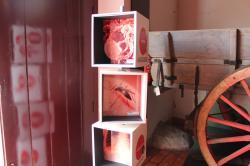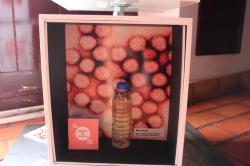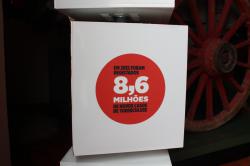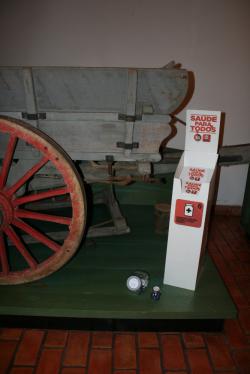How to do it step by step
1st Step:
What do we want to focus on in MDG 6 and why?
The major goal of MDG 6 is to stop and reverse the spread of HIV/AIDS by 2015 and to achieve universal access to HIV/AIDS treatment for all who need it by 2020. So, we knew we had to emphasize this theme, showing clearly the causes and consequences of the virus. In addition, with the younger audience in mind, we had to pay special attention to the language and ensure that the message was not discriminatory or dubious.
As we did not want the installation to focus solely on HIV/AIDS, we identified other diseases with a profound impact on contemporary societies, particularly diseases with known cures or that are easily preventable. However, the inequality of access to medicines or social inequalities do not allow diseases such as malaria, tuberculosis or diarrhoea to be cured or prevented.
2nd Step:
The location
After choosing the topic, we needed to think about the space where the installation would be located and how we could link our topic to the museum objects already displayed in that space. It should be emphasised that the dimensions of the space and its ease of access help determine what type of structure can be developed.
3rd Step:
Get to work
With the topic and location decided on, it is necessary to think about the materials needed for the installation, to consult suppliers and obtain quotes. It is important to identify a supplier who can meet the design and printing requirements. We should not overlook the environmental impact of our installation and, as such, we should choose, wherever possible, reusable, recycled or certified materials.
4th Step:
Schedule
It is important to set a schedule (deadlines) for delivery of services, setting up the installation and for its inauguration.
5th Step:
The support materials
Identify support materials for the installation, such as the leaflet, which present context, facts and figures in a clear way. All materials should be consistent in terms of graphics, as this installation will be part of a set of ten installations.
6th Step:
The message
What to say: The message should be clear, brief, accurate and presented in an appealing way. As we are dealing with a theme that is associated with stigmas and value judgments, it is essential to ensure that the content does not suggest double-meanings. Therefore, we should avoid using humour, which can be misinterpreted.
Research: Ensure that data is current and accurate, and is drawn from reliable and credible sources.
Writing: Use language that is accessible to all sections of the public and ensure that typography (font, size, colour) is conducive to reading.
7th Step:
Approval of the support materials
Leaflet: Ensure that it fits with the topic and that it provides a global and local view of the challenges. Present ways to take concrete action and sites where people can learn more about the subject. The leaflet should have a visual link to the topic under discussion.
Signpost: this attracts visitors’ attention to the installation and the theme. Opt for a picture with a brief caption.
Throughout this process, ensure that the museum agrees with everything that is written in all the support materials and that the graphic design is consistent between all the materials.
8th Step:
Installing it in the museum
Whenever possible, schedule the inauguration of the installation for a symbolic date.
The installation is designed to give various levels of information to visitors. It consists of four cubes, each one representing one of the deadliest diseases in the world: malaria; HIV/AIDS; tuberculosis and diarrhoea. Three sides of each cube present relevant facts and figures on the disease. The other side of the cube is "open" revealing a small "niche" with an image of the disease and a package containing the type of treatment available. For example, in the Malaria cube there is an image of the mosquito that spreads the disease and the packaging from an antimalarial drug. In the case of HIV/AIDS prevention, we put some female and male condoms, overlapping on top of an image of the virus. For tuberculosis, we chose an image of lungs being attacked by the disease and the specific drugs used to combat this disease. For diarrhoea, we used an image of contaminated water and the salts used to fight this disease.
Visitors can touch all the objects and rotate the boxes to collect more information. This installation was arranged in a museum room displaying agricultural tools. In this way, we can address the effects of malnutrition associated with these diseases, on the one hand, and, on the other hand, show the impact that food security and food sovereignty will have on those so-called new global diseases like obesity and malnutrition.
Dimensions of the installation:
Structure: 1.60 m high by 40 cm wide.
9th Step:
Communication plan
The preferred channel of communication was the Facebook page "Connected for a Better World ", where we posted formative and informative content on certain diseases and their impacts, as well as on global and local achievements in relation to this issue.
Since we are addressing controversial social topics, such as HIV/AIDS and the many stereotypes associated with it, it is essential that the language is clear and positive. The focus should always be on prevention, patient care and action (or lack of it) taken by the competent authorities in response to the diseases in question.
We increased publicity on the installation through the use of a Flashmail: a short, very visual email that invites people to visit the installation and learn more about the project.
10th Step:
Inauguration of the installation
Ideally, a date should be chosen for inaugurating the installation. For maximum impact, we recommend choosing a symbolic date. If possible, you may also wish to consider organizing a small debate on the subject.
11th Step:
Publicity
The installation has been widely publicised through the social networks of partners and partners’ preferred contacts (in this case patient organizations and pharmaceutical companies).























